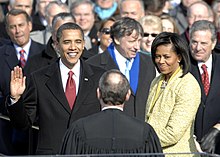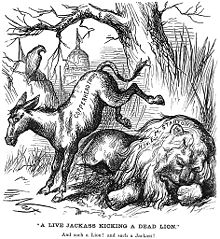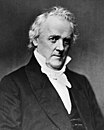Democratic Party (United States)
|
Democratic Party Democratic Party |
|
|---|---|

|
|

|
|
| Party leader | Jaime Harrison (Chair) |
| Secretary General | Jason Rae |
| Chairman of the Senate parliamentary group | Majority Leader Charles Schumer ( NY ) ( Democratic Conference ) |
| Chairman of the House of Representatives | Majority Leader Steny Hoyer ( MD ) |
| founding | January 8, 1828 |
| Headquarters | 430 South Capitol Street SE Washington, DC 20003 |
| Youth organization |
Young Democrats of America High School Democrats of America College Democrats of America |
| Alignment | American Liberalism Currents: American Progressivism Social Democracy Centrism Conservatism |
| Colours) | Blue (unofficial) |
| House of Representatives |
222/435 |
| senate |
48/100 |
| Number of members | 47,106,084 (2020) |
| International connections | Progressive Alliance |
| Website | www.democrats.org |
| Two senators of the 116th Congress are non-party, but belong to the parliamentary group (caucus) | |
The Democratic Party ( english Democratic Party , as Democrats ( Democrats ) or short Dems called) has about 47 million registered supporters alongside the Republican Party , the larger of the two major parties in the United States . Originally a party that advocated racial segregation , the Democrats are now, compared to the Republicans, more (left) liberal, less conservative and more oriented towards political progressivism . Their unofficial heraldic animal is the donkey , although, unlike the Republican elephant, it was never officially adopted as such. Like the Republican elephant, its origins go back to the cartoonist Thomas Nast . The Democrats' unofficial party color is blue . In TV broadcasts or media reports, senators and party members of the Democratic Party are usually shown with a “(D)” after their name. The Democrats are the oldest surviving political party in the world.
The founding of the party goes back to Thomas Jefferson and the year 1792. In 1828 Andrew Jackson and others built a mass party. While the Democrats were initially the more conservative of the two parties, at the beginning of the 20th century it developed into an ideologically incoherent alliance of progressive politicians in the big cities of the north, who primarily addressed workers and immigrants, and of conservative southerners, who the defended the existing order. During Woodrow Wilson's presidency (1913–1921) and particularly through the reforms of the New Deal (1933–1938), the Democrats were identified more and more with progressive social policies in contrast to the economic liberalism of the Republicans. After the 1948 party congress , when many representatives of racial segregation, mostly from the southern states , left the party in dispute, the Democrats had been leaders since the 1960s in realizing the demands of the civil rights movement , the abolition of racial segregation and equality for minorities: the party increasingly turned to social liberal ideas. Since the originally progressive Republicans for their part moved to the right by 1964 at the latest , the two parties now clearly represent the two poles in a right-left spectrum .
Like parties in the US in general, the Democrats are organized much differently than European parties. Depending on the state , district boards are partly elected by the general electorate in primary elections and not, for example, by party members alone. The most important organ for the entire party is the Democratic National Committee (DNC, "Democratic National Committee"), which also organizes the Democratic National Convention (the party convention held every four years for the free choice of the respective presidential candidate); the current chairman of the DNC is Jaime Harrison .
In seven of the last eight presidential elections, the Democratic candidates won a majority of the votes cast ( Popular Vote ); only 2004 was an exception. With Joe Biden , the party has been the 46th US President since 2021 . In the congressional elections in November 2020, the Democrats were able to defend their majority in the House of Representatives , which they lost in 2010 and regained in 2018 . The democratic parliamentary group has also had a majority in the Senate since the beginning of 2021, after losing it in 2015.
story



Development phase
The forerunners of the Democratic Party were the Anti-Administration Party and the coalition around Thomas Jefferson in Congress in 1792, with which the policy of the then US Treasury Secretary Alexander Hamilton was to be undermined. From the first quarter of the 19th century, the former main opponents of the then Republicans (later Democratic Republicans ) party, the Federalists around Alexander Hamilton and John Adams , were no longer politically active. Therefore dominated Jefferson's party as only the so-called Era of Good Feelings , era of good feelings' (ca. 1814-1830).
In the late 1820s and 1830s, almost all US states abolished the previously existing voting restrictions due to property and tax payments, so that almost all white men were eligible to vote and the first democracy in the modern sense emerged; in addition, the population of the United States increased sharply due to immigration. Overall, therefore, the number of voters increased massively. The US parties that existed until then (including the Jefferson party) were essentially small, informal electoral associations that were no match for the emerging mass democracy. Not only Thomas Jefferson, but also Andrew Jackson , who was the seventh President of the United States from 1829 to 1837, is honored as the party's founding father. In the presidential election in 1824 , he ran as well as three other candidates of the then Democratic Republicans , which led to the split in the only national party. Jackson narrowly lost the election to John Quincy Adams , whereupon Adams became supporters of the party to the National Republicans , while the Jeffersonian Democrats formed the new Democratic Party, which saw itself in the tradition of Jefferson. From 1828 to 1830, Andrew Jackson and Martin Van Buren , the Senator from New York , formed the Democratic Party, the first strictly organized people's party in the world. The year 1828 is therefore considered to be the founding year of the Democrats. Their opponents from the short-lived National Republican Party organized themselves after the deselection of Adams by Jackson in 1828 and Henry Clay's defeat in 1832 as Whigs , from 1854 increasingly with the newly founded Republican Party .
Jackson represented the interests of ordinary people in a line of tradition with Thomas Jefferson (especially from rural areas and the poorer part of the population, increasingly also of immigrants and Catholics). He opposed a US national bank, fought protectionism and advocated slavery . Because he mistrusted the growth of the big cities, he advocated a more even population distribution. That is why both he and his successors massively support the fight against the Indians , who at that time still owned large areas in rural areas. Jackson is considered an early proponent of populism and the first American politician to build a party machine in the modern sense of the word.
Second half of the 19th century
In the years before 1860, due to the dividedness of their opponents and the consequent exploitation of certain peculiarities of the constitution, the Democrats succeeded in controlling the US government, although only a minority of voters stood behind them. Before the civil war , however, the party faced an ordeal because of the slave issue. On the occasion of the presidential elections in 1860, it split and sent different candidates in the north and south in the race for the presidency. When, because of this disagreement, the Republican Abraham Lincoln was elected, this sparked the Civil War . After the end of the civil war in 1865, the Republicans dominated the south and initially also parts of the north, because many who had worked with the Confederacy were deprived of the right to vote during the military occupation of the southern states known as " Reconstruction " . Only with the end of the "Reconstruction" did the Democrats play an important role again at the national level. Its power base was mainly in the south ( Solid South ), but also in the big cities of the north, where it found support among workers, immigrants and Catholics.
From the populist movement at the end of the century, the party took up new ideas and increasingly fought industrial cartels and "railroad barons". With the candidacy of William Jennings Bryan in 1896, the "left profile" of the Democrats increased. During this time she tightened her party organization and the internal party "principle of bosses". However, there were increasing allegations of corruption against the party. At the same time, the party adhered to the principle of racial segregation and consistently used the freedom of action regained after the end of the Reconstruction to curtail the rights of blacks in the southern states ( Jim Crow laws ).
Since the 20th century
It was not until the beginning of the 20th century that the progressivist reformers began to gain influence in the party. The Democratic Party increasingly advocated social reforms in the form of enlightened social liberalism , for example a general income tax , direct elections to the Senate , alcohol prohibition and women's suffrage . The Democratic President Woodrow Wilson tried to found the League of Nations , the forerunner of the UN . The League of Nations was established, but just the United States did not join because this plan is no majority in the increasingly isolationist aligned Congress found.
A high point of these reforms, which many even consider the highlight of an American, non-Marxist version of social democracy , was the New Deal under President Franklin D. Roosevelt in response to the Great Depression in the 1930s. Among other things, the legislature, under Roosevelt's leadership, introduced social security in the United States. Roosevelt's successor Harry S. Truman tried to keep the programs going, but was faced with a Congress dominated by conservative politicians from both parties, which made the further expansion of the New Deal programs difficult.
Under Truman, the Democrats, who had long sympathized with racist groups such as the Ku Klux Klan , increasingly began to address racial discrimination . In 1948, Truman ordered the abolition of racial segregation in the US armed forces with his Executive Order 9981, and the nomination congress in the same year declared the abolition of racial segregation a long-term party goal for the first time. However, this policy of Truman and other Democrats, mainly from the northern states, met with strong opposition from the conservative wing of the party from the southern states. For example, for the presidential election in 1948 , the Dixiecrats, a southern grouping, split off and nominated Strom Thurmond as a candidate of their own. This actually won four southern states and 39 electors. Nationwide, however, the Dixiecrats had no chance, Truman won over Thurmond as well as Thomas E. Dewey , the Republican applicant.
This initiated a shift to the left of the party, which continues to have an impact today. Tensions within the party increased during the 1950s, but initially the South remained influential and in 1960 was able to persuade John F. Kennedy to make such far-reaching concessions that most of the African-American delegates left the nomination convention in protest. But after the election of President Kennedy won the civil rights movement continues to influence. Kennedy began to advocate social reform in the New Deal tradition . Until his assassination in 1963 , however, only modest progress had been made in domestic reforms. Under his successor Lyndon B. Johnson, however, who was confirmed by a clear majority in 1964 , the social reforms reached a new high with the Great Society . Republican Barry Goldwater stood up against Johnson , who targeted those voters in the southern states who were in favor of racial segregation and who opposed government interference.
In addition to the fight against poverty (the number of US citizens living in poverty was almost halved within five years), comprehensive reforms in the areas of education, health and environmental protection, Johnson's program of the Great Society meant the strengthening of civil rights for African Americans and other minorities. Johnson passed the Civil Rights Act of 1964 (before the presidential election), which abolished racial segregation nationwide, the Voting Rights Act to empower black people to vote, and the Civil Rights Act of 1968 . At the same time, the conservative southern wing lost massive influence, while the left-wing liberal part of the Democrats from the northeastern states and from the Pacific coast gained political weight and dominated the Democrats from then on.
The programs to strengthen civil rights resulted in Afro-Americans being arguably the most stable group of Democrats to date. At the same time, they contributed - together with the growing political influence of Christian fundamentalism - to the fact that the southern states changed from an almost completely democratic to an almost completely republican area ( Solid South ) within a few years , as the Republicans, for their part, have continued to move forward since Goldwater's presidential candidacy moved to the right and targeted conservative white voters in the southern states as part of the Southern Strategy . Johnson, himself a Texan, is said to have prophesied this after the Civil Rights Act was signed: “ I think we just gave the South to the Republicans. ”
During the National Convention (the nomination party convention for the presidential election) of the Democrats from August 26 to August 28, 1968 in Chicago , students protested against participation in the Vietnam War . Chicago's Democratic Mayor Richard J. Daley used very repressive police tactics, and street battles lasted for days. The clashes were a bloody climax of the American 1968 movement . At the same time, the Democratic Party was divided over the entry into the Vietnam War under Kennedy and Johnson, which in late 1968 favored Richard Nixon's electoral victory over the left-wing liberal Hubert H. Humphrey and the conservative former southern Democrat George Wallace , who ran for the American Independent Party .
Nevertheless, the Democrats retained their majorities in both chambers of Congress until 1981, when the election of Republican Ronald Reagan as president began a conservative era. It was not until the 1994 elections that Republicans won majorities in both houses of the American legislature , after Democrat Bill Clinton had moved into the White House two years earlier . After Jimmy Carter's tenure (1977 to 1981) he was the first head of state appointed by the Democratic Party in twelve years. In 2000, the Democrat Al Gore won the majority of votes nationwide ( Popular vote ), but was subject to the Republican George W. Bush due to the peculiarities of US electoral law . This was followed in 2009 by Barack Obama, another Democratic President. This met with passionate opposition from many Republicans, who in many cases denied his presidency legitimacy; Although he was re-elected in 2012, the majority in Congress that had gone back to the Democrats under Bush, won the Republicans.
Before the Democrats lost their majority in the House of Representatives at the end of 2010, however, they managed to pass a reform package designed to improve medical care for low-income citizens ( Obamacare ).
Since the 9/11 attacks , the Democrats have been trying to find an appropriate political position on the subject of terrorism / national security. Although generally critical of George W. Bush's policies, which are perceived as aggressive , the positions range from fundamental criticism to skepticism in detail. Celebrities at the party today include Joe Biden , Jerry Brown , Hillary Clinton , Howard Dean , John Kerry , Nancy Pelosi , Harry Reid , Bernie Sanders , Elizabeth Warren and Kamala Harris .
Todays situation
Today the Democratic Party has moved somewhat to the left compared to the Republican Party . The support of the white workers, despite the greater proximity to the trade union , has become increasingly weaker for cultural and social reasons. This development goes hand in hand with the loosening of the union milieu .
Although the party in the south is still significantly more conservative than in the rest of the USA, the “ deep south ” is now considered the Republican home country in federal elections (see Richard Nixon's “Southern strategy” ). There are exceptions in those communities in which Afro-American or Hispanics make up the majority (although the latter are less committed to the Democrats than the other minorities), in individual strongholds such as New Orleans, or partially if - as in the case of President Carter (1976 ) and Clinton (1992) - the presidential candidate himself came from the southern states.
With the turning of the conservative southerners to the Republicans, it seemed difficult for the Democrats to regain federal dominance - especially since the previously backward southern states have undergone an enormous economic modernization process since the 1960s, which affects the societal attitude to cultural issues such as The death penalty , abortion , same-sex marriage or school prayer has changed little. The Southeast and Texas are two of the most dynamic growth regions in the US, including associated immigration and population growth. Since 1992, apart from 2004, the Democrats have won a majority of the votes in the presidential elections at the federal level; This is helped by the fact that women and members of the rapidly growing ethnic minorities often prefer the democrats for socio-political reasons.
The fact that the Democrats now have their strongholds primarily in the more populous states of the northeast , the Great Lakes and the Pacific coast, while most of the smaller inland states are dominated by the Republicans, has the effect of due to the presidential election law in force in the USA with majority voting at the state level that Democrats tend to need more votes than Republicans to win. These rural states with fewer electorates are more inclined to the Republicans, as was shown in the 2016 presidential election when Hillary Clinton lost to Republican Donald Trump despite a lead of almost 2.9 million votes in the Popular Vote .
symbol
As a symbol of the Democratic Party often acts the donkey ( Donkey ). The exact origin of the heraldic animal is controversial, it has appeared since around 1830 under the presidency of Andrew Jackson . At times the rooster was also considered a symbol of the party, but this was pushed back after the appearance of a cartoon by Thomas Nast in Harper's Weekly magazine , and the donkey prevailed. However, this animal has never been officially recognized by the party, although it is used by individual party associations.
According to the party's own history, presidential candidate Andrew Jackson was referred to in 1828 by his opponents as a "donkey". He decided to use the strong-willed animal as a symbol in the election campaign. In 1874 a cartoon showed the donkey in a lion costume frightening an elephant with the words "Republican Voters" on it. The elephant threatened to fall into a trap of inflation and rejection. This is how the symbolic animal of the Republicans was born.
organization
The party's main organization at the federal level is the Democratic National Committee , which organizes the biennial party conference, the Democratic National Convention , and collects donations. There are sub-organizations in each state.
There are also some societal associations, such as the youth organizations Young Democrats of America and High School Democrats of America , the College Democrats of America, and the National Federation of Democratic Women . Democrats living abroad are organized in Democrats Abroad .
In the Senate there is a parliamentary group of the Senate Democratic Caucus and in the House of Representatives the House Democratic Caucus .
Party Associations in the States
Party associations in the territories
| Party association | Chairman | Seat upper chamber | Seat lower chamber | logo |
|---|---|---|---|---|
| American Samoa Democratic Party |
Minnie Tuia ( executive ) |
0/18 |
0/21 |
|
| District of Columbia Democratic State Committee | Charles Wilson |
10/13 |
||
| Democratic Party of Guam | Regine Lee |
10/15 |
||
| CNMI Democratic Party | Nola Hix |
0/9 |
0/20 |
|
| Democratic Party of Puerto Rico | Charlie Rodríguez |
0/30 |
0/51 |
|
| Democratic Party of the Virgin Islands | Donna Christian-Christensen |
13/15 |
||
Democratic President of the USA
The Democrats have so far (as of 2021) appointed 16 presidents, Cleveland being the only president with two separate terms in office twice in the presidential count. After the Republicans, who had 19 presidents, they are in second place. From 1861 to 2021, Democratic presidents had 17 terms and Republicans had 23. The US presidents appointed by the Democratic Party were:
Andrew Jackson
1829-1837Martin Van Buren
1837–1841James K. Polk
1845-1849Franklin Pierce
1853-1857James Buchanan
1857-1861Andrew Johnson
1865–1869 note 1Grover Cleveland
1885–1889 and 1893–1897Woodrow Wilson
1913-1921Franklin D. Roosevelt
1933-1945Harry S. Truman
1945-1953John F. Kennedy
1961-1963Lyndon B. Johnson
1963-1969Jimmy Carter
1977-1981Bill Clinton
1993-2001Barack Obama
2009-2017Joe Biden
since 2021
They also provided the only President of the Confederate States of America :
Jefferson Davis
1861-1865
Presidential election
The candidate emerged from the elections as the winner and thus incumbent.
The candidate emerged from the elections as the loser.
Only supported candidates are highlighted in gray, which has happened once before: In the 1872 election, the candidate Horace Greeley died before the vote of the electoral college; the three votes cast for him were declared invalid and the incumbent President and candidate of the Republican Party Ulysses S. Grant was re-elected.
* The candidate was already President at the time of the election.
° The candidate lost the election despite a majority in the Popular Vote.
| year | Candidate president |
Electoral votes (absolute) |
Electoral votes (percentage) |
electors | Electors (percentage) |
|---|---|---|---|---|---|
| 1828 | Andrew Jackson | 642,553 | 56.0% | 178 | 68.2% |
| 1832 | Andrew Jackson * | 701.780 | 54.2% | 219 | 76.6% |
| 1836 | Martin Van Buren | 764.176 | 50.8% | 170 | 59.4% |
| 1840 | Martin Van Buren * | 1,128,854 | 46.8% | 60 | 20.4% |
| 1844 | James K. Polk | 1,339,494 | 49.5% | 170 | 61.8% |
| 1848 | Lewis Cass | 1,223,460 | 42.5% | 127 | 43.9% |
| 1852 | Franklin Pierce | 1,607,510 | 50.8% | 254 | 85.8% |
| 1856 | James Buchanan | 1,836,072 | 45.3% | 174 | 58.8% |
| 1860 | Stephen A. Douglas (North) | 1.380.202 | 29.5% | 12th | 3.9% |
| 1860 | John C. Breckinridge (South) | 848.019 | 18.1% | 72 | 23.8% |
| 1864 | George B. McClellan | 1,812,807 | 45.0% | 21 | 9.0% |
| 1868 | Horatio Seymour | 2,708,744 | 47.3% | 80 | 27.2% |
| 1872 | Horace Greeley | 2,834,761 | 43.8% | 3 (invalid) | - |
| 1876 | Samuel J. Tilden | 4,288,546 | 51.0% | 184 | 49.9% |
| 1880 | Winfield Scott Hancock | 4,444,260 | 48.3% | 155 | 42.0% |
| 1884 | Grover Cleveland | 4,874,621 | 48.5% | 219 | 54.6% |
| 1888 | Grover Cleveland * | 5,534,488 | 48.6% | 168 | 41.9% |
| 1892 | Grover Cleveland | 5,553,898 | 46.0% | 277 | 62.4% |
| 1896 | William Jennings Bryan | 6,508,172 | 46.7% | 176 | 39.4% |
| 1900 | William Jennings Bryan | 6,370,932 | 45.5% | 155 | 34.7% |
| 1904 | Alton B. Parker | 5,083,880 | 37.6% | 140 | 29.4% |
| 1908 | William Jennings Bryan | 6,408,984 | 43.0% | 162 | 33.5% |
| 1912 | Woodrow Wilson | 6,296,184 | 41.8% | 435 | 81.9% |
| 1916 | Woodrow Wilson * | 9,126,868 | 49.2% | 277 | 52.2% |
| 1920 | James M. Cox | 9,139,661 | 34.1% | 127 | 23.9% |
| 1924 | John W. Davis | 8,386,242 | 28.8% | 136 | 25.6% |
| 1928 | Al Smith | 15,015,464 | 40.8% | 87 | 16.4% |
| 1932 | Franklin D. Roosevelt | 22,821,277 | 57.4% | 472 | 88.9% |
| 1936 | Franklin D. Roosevelt * | 27,752,648 | 60.8% | 523 | 98.5% |
| 1940 | Franklin D. Roosevelt * | 27,313,945 | 54.7% | 449 | 84.6% |
| 1944 | Franklin D. Roosevelt * | 25,612,916 | 53.4% | 432 | 81.4% |
| 1948 | Harry S. Truman * | 24.179.347 | 49.6% | 303 | 57.1% |
| 1952 | Adlai Stevenson | 27.375.090 | 44.3% | 89 | 16.8% |
| 1956 | Adlai Stevenson | 26,028,028 | 42.0% | 73 | 13.7% |
| 1960 | John F. Kennedy | 34.220.984 | 49.8% | 303 | 56.4% |
| 1964 | Lyndon B. Johnson * | 43.127.041 | 61.1% | 486 | 90.3% |
| 1968 | Hubert H. Humphrey | 31,271,839 | 42.7% | 191 | 35.5% |
| 1972 | George McGovern | 29.173.222 | 37.5% | 17th | 3.2% |
| 1976 | Jimmy Carter | 40,831,881 | 50.1% | 297 | 55.2% |
| 1980 | Jimmy Carter * | 35.480.115 | 41.0% | 49 | 9.1% |
| 1984 | Walter Mondale | 37,577,352 | 40.6% | 13th | 2.4% |
| 1988 | Michael Dukakis | 41,809,476 | 45.6% | 111 | 20.6% |
| 1992 | Bill Clinton | 44.909.806 | 43.0% | 370 | 68.8% |
| 1996 | Bill Clinton * | 47.400.125 | 49.2% | 379 | 70.4% |
| 2000 | Al Gore | 51.003.926 | 48.4% | 266 | 49.5% |
| 2004 | John Kerry | 59,028,439 | 48.3% | 251 | 46.7% |
| 2008 | Barack Obama | 69,456,897 | 52.9% | 365 | 67.8% |
| 2012 | Barack Obama * | 65.910.437 | 51.1% | 332 | 61.7% |
| 2016 | Hillary Clinton | 65,844,610 | 48.2% | 232 | 43.1% |
| 2020 | Joe Biden | 81.284.778 | 51.3% | 306 | 56.9% |
Party organizations
This is a partial list of official and unofficial organizations affiliated with the Democratic Party:
- Blue Dog Coalition
- Center for American Progress
- Democrats for Life of America
- New Democrat Coalition
- Stonewall Democrats
- Young Democrats of America
See also
- List of United States Political Parties
- Yellow dog Democrat
- Democratic Caucus of the United States Senate
literature
- Jules Witcover: Party of the People: A History of the Democrats . Random House, New York City 2003, ISBN 0-375-50742-6 .
- Robert Allen Rutland: The Democrats: From Jefferson to Clinton . (Updated edition). University of Missouri, Columbia 1995, ISBN 0-8262-1034-1 .
Web links
- The Democratic Party (English)
- Democrats Abroad (English)
- William P. Meyers: A Brief History of the Democratic Party. In: IIIPublishing , 2004 (English)
Individual evidence
- ^ Syed Ali Raza: Social Democratic System . Global Peace Trust, 2012, p. 91.
- ↑ Richard Winger: November 2020 Ballot Access News. In: ballot-access.org. November 21, 2020, accessed February 11, 2021 .
- ^ Participants. In: Website of the Progressive Alliance . Retrieved January 5, 2016 .
- ↑ Christof Mauch: The American Presidents . CH Beck, Munich, ISBN 978-3-406-58742-9 , p. 333.
- ↑ American President: Harry S. Truman: Domestic Affairs ( Memento of September 27, 2013 in the Internet Archive )
- ^ Robert Dallek: Lyndon B. Johnson: Portrait of a President. Oxford University Press, ISBN 0-19-515921-7 , pp. 234ff.
- ↑ American President: Lyndon B. Johnson - Domestic Affairs
- ↑ Thomas Nast Portfolio: A Live Jackass Kicking a Dead Lion . Ohio State University (English).

























